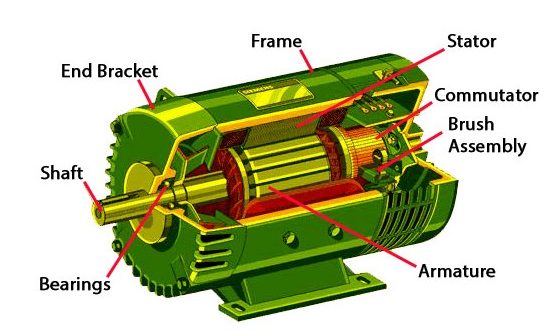Whenever you are asked how an electric motor functions, you need to understand that it is a device that converts electrical energy into mechanical energy. Several components are involved in an electric motor’s operation, including the armatures, field magnets, and the commutator. This article will discuss the function of an electric motor.
Commutator
Whenever a DC motors Toledo, OH, or generator runs, the motor’s commutator acts as the mechanical rectifier. This device periodically changes the direction of current in the rotor’s windings, ensuring that the current flow in the external circuit continues in only one direction.
A commutator is a set of contact bars fixed to a rotating shaft. The segments of a commutator are electrically connected to the rotor windings through brushes. As a result, the commutator has an exceptionally long service life.
Commutators are made of small, narrow copper bars insulated by the mica. They are also made of a dovetail shape, allowing them to be repositioned or replaced individually.
Field Magnets
During an electric motor’s lifecycle, the field magnets interact with each other to produce rotation. A commutator switches the current direction through the armature as the rotor rotates.
The magnetic field that is created is called an induced magnetic field. This is a temporary magnetic field that produces a north and south pole. Unlike a permanent magnet, this magnetic field is repelled by the other magnet, which produces a torque that can rotate the motor.
The magnetic field in an electric motor is created by supplying current to the conductor. The magnetic field is created by electrons orbiting the atoms in the conductor. A larger current through the conductor forces the electrons to align in a uniform direction.
Armatures
Whenever an electric motor spins, it generates torque by passing a current through its windings. The force generated by the windings is then transferred to the rotor. To generate torque, the armature must carry current and be oriented properly.
The armature is made up of the core, which is a cylindrical piece of steel or metal, and laminations. The laminations are stamped with slots around the edges where the coils are located. These slots are usually 0.5mm thick.
The core is usually held in place by a coarse knurl. This coarse knurl is similar to the knurl on the shaft. Older armatures were made using sheet mica.
Electromagnetism
Electrified motors use the interaction of magnetism and electricity to convert electrical energy into mechanical energy. In the process, electricity and magnetism create a torque that causes the motor to rotate. This torque is derived from the vector product of the interacting fields.
Electromagnetism is a branch of science that deals with the interaction of electric current and fixed magnetic fields. Almost all of us have come into contact with electromagnetic motors in our everyday lives. These electric motors are used in everything from power tools to electric vehicles. They are also used in appliances and the electronics industry.
Electromagnetism in an electric motor begins with creating a magnetic field around the current-carrying conductor. The magnetic field is made up of lines of flux, and when the conductor is in the field, it creates a torque on the wire loop.
Output Power
Whether designing a new vehicle or repairing an existing one, you should understand how to calculate the output power of an electric motor. There are two important factors to consider when calculating this type of power. First, you’ll also want to know how to calculate the input power of the motor.
The output power of an electric motor is derived from the motor’s maximum energy transformation capacity (METC) and the torque produced at the rated speed. The watts or joules per second resulting from this calculation are typically referred to as the “power” of the motor.
The watts or joules of the power are also measured in foot pounds or Newtons. The best way to calculate these values is to use the equation: watts x torque = output power.
 Blog For Noob Random thought of a Noob Blogger
Blog For Noob Random thought of a Noob Blogger









